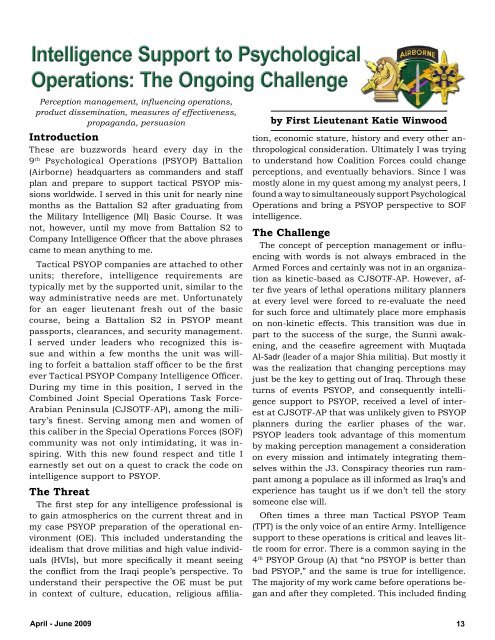Military Intelligence Professional Bulletin - Federation of American ...
Military Intelligence Professional Bulletin - Federation of American ...
Military Intelligence Professional Bulletin - Federation of American ...
Create successful ePaper yourself
Turn your PDF publications into a flip-book with our unique Google optimized e-Paper software.
Perception management, influencing operations,<br />
product dissemination, measures <strong>of</strong> effectiveness,<br />
propaganda, persuasion<br />
Introduction<br />
These are buzzwords heard every day in the<br />
9 th Psychological Operations (PSYOP) Battalion<br />
(Airborne) headquarters as commanders and staff<br />
plan and prepare to support tactical PSYOP missions<br />
worldwide. I served in this unit for nearly nine<br />
months as the Battalion S2 after graduating from<br />
the <strong>Military</strong> <strong>Intelligence</strong> (MI) Basic Course. It was<br />
not, however, until my move from Battalion S2 to<br />
Company <strong>Intelligence</strong> Officer that the above phrases<br />
came to mean anything to me.<br />
Tactical PSYOP companies are attached to other<br />
units; therefore, intelligence requirements are<br />
typically met by the supported unit, similar to the<br />
way administrative needs are met. Unfortunately<br />
for an eager lieutenant fresh out <strong>of</strong> the basic<br />
course, being a Battalion S2 in PSYOP meant<br />
passports, clearances, and security management.<br />
I served under leaders who recognized this issue<br />
and within a few months the unit was willing<br />
to forfeit a battalion staff <strong>of</strong>ficer to be the first<br />
ever Tactical PSYOP Company <strong>Intelligence</strong> Officer.<br />
During my time in this position, I served in the<br />
Combined Joint Special Operations Task Force-<br />
Arabian Peninsula (CJSOTF-AP), among the military’s<br />
finest. Serving among men and women <strong>of</strong><br />
this caliber in the Special Operations Forces (SOF)<br />
community was not only intimidating, it was inspiring.<br />
With this new found respect and title I<br />
earnestly set out on a quest to crack the code on<br />
intelligence support to PSYOP.<br />
The Threat<br />
The first step for any intelligence pr<strong>of</strong>essional is<br />
to gain atmospherics on the current threat and in<br />
my case PSYOP preparation <strong>of</strong> the operational environment<br />
(OE). This included understanding the<br />
idealism that drove militias and high value individuals<br />
(HVIs), but more specifically it meant seeing<br />
the conflict from the Iraqi people’s perspective. To<br />
understand their perspective the OE must be put<br />
in context <strong>of</strong> culture, education, religious affilia-<br />
by First Lieutenant Katie Winwood<br />
tion, economic stature, history and every other anthropological<br />
consideration. Ultimately I was trying<br />
to understand how Coalition Forces could change<br />
perceptions, and eventually behaviors. Since I was<br />
mostly alone in my quest among my analyst peers, I<br />
found a way to simultaneously support Psychological<br />
Operations and bring a PSYOP perspective to SOF<br />
intelligence.<br />
The Challenge<br />
The concept <strong>of</strong> perception management or influencing<br />
with words is not always embraced in the<br />
Armed Forces and certainly was not in an organization<br />
as kinetic-based as CJSOTF-AP. However, after<br />
five years <strong>of</strong> lethal operations military planners<br />
at every level were forced to re-evaluate the need<br />
for such force and ultimately place more emphasis<br />
on non-kinetic effects. This transition was due in<br />
part to the success <strong>of</strong> the surge, the Sunni awakening,<br />
and the ceasefire agreement with Muqtada<br />
Al-Sadr (leader <strong>of</strong> a major Shia militia). But mostly it<br />
was the realization that changing perceptions may<br />
just be the key to getting out <strong>of</strong> Iraq. Through these<br />
turns <strong>of</strong> events PSYOP, and consequently intelligence<br />
support to PSYOP, received a level <strong>of</strong> interest<br />
at CJSOTF-AP that was unlikely given to PSYOP<br />
planners during the earlier phases <strong>of</strong> the war.<br />
PSYOP leaders took advantage <strong>of</strong> this momentum<br />
by making perception management a consideration<br />
on every mission and intimately integrating themselves<br />
within the J3. Conspiracy theories run rampant<br />
among a populace as ill informed as Iraq’s and<br />
experience has taught us if we don’t tell the story<br />
someone else will.<br />
Often times a three man Tactical PSYOP Team<br />
(TPT) is the only voice <strong>of</strong> an entire Army. <strong>Intelligence</strong><br />
support to these operations is critical and leaves little<br />
room for error. There is a common saying in the<br />
4 th PSYOP Group (A) that “no PSYOP is better than<br />
bad PSYOP,” and the same is true for intelligence.<br />
The majority <strong>of</strong> my work came before operations began<br />
and after they completed. This included finding<br />
April - June 2009 13
















